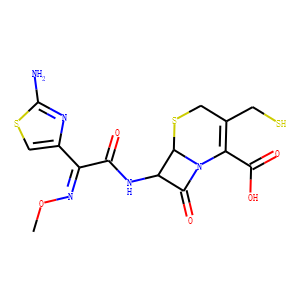| Reference | [1]. J Pharm Sci. 1997 Mar;86(3):389-95. doi: 10.1021/js950503g.<br />
Controlled hydrolysis of ceftiofur sodium, a broad-spectrum cephalosporin; isolation and identification of hydrolysis products.<br />
Koshy KT(1), Cazers AR.<br />
Author information: (1)Animal Health Drug Metabolism, The Upjohn Company, Kalamazoo, MI 49001, USA.<br />
Ceftiofur sodium is the salt of (6R,7R)-7-{[(2-amino-4-thiazolyl)-Z-(methoxyimino)acetyl]amino}-3-{[(2-+ ++furanylcarbonyl)thio]methyl}-8-oxo-5-thia-1-azabicyclo[4.2.0]oct-2- ene-2-carboxylic acid. This compound is very susceptible to acid, alkaline-, and enzyme-catalyzed hydrolysis, producing a number of unstable degradation products. In this report, we describe the preparation and identification of the hydrolysis products that are formed under controlled alkaline conditions. The primary hydrolysis product was desfuroyl ceftiofur, which is the most abundant metabolite in bovine blood. Desfuroyl ceftiofur was carefully oxidized with H2O2 to prepare the disulfide dimer, a urinary metabolite of ceftiofur sodium in the rat and cattle. Under acidic conditions, desfuroyl ceftiofur was converted to the corresponding thiolactone. The preparation of desacetyl cefotaxime, which is the oxygen analog of desfuroyl ceftiofur, is also described. Furoic acid was readily formed by hydrolytic cleavage of the thioester bond. Thiofuroic acid, formed by the less common cleavage on the alkyl side of the thioester bond, was also isolated.<br />
DOI: 10.1021/js950503g PMID: 9050811 [Indexed for MEDLINE]<br />
<br />
[2]. Food Addit Contam Part A Chem Anal Control Expo Risk Assess. 2016;33(3):403-19. doi: 10.1080/19440049.2015.1125529. Epub 2016 Jan 25.<br />
Evaluation and validation of a multi-residue method based on biochip technology for the simultaneous screening of six families of antibiotics in muscle and aquaculture products.<br />
Gaudin V(1), Hedou C(1), Soumet C(1), Verdon E(1).<br />
Author information: (1)a European Union Reference Laboratory, Anses Fougeres , La Haute Marche – BP 90203 , F-35302 Fougeres Cedex , France.<br />
The Evidence Investigator™ system (Randox, UK) is a biochip and semi-automated system. The microarray kit II (AM II) is capable of detecting several compounds belonging to different families of antibiotics: quinolones, ceftiofur, thiamphenicol, streptomycin, tylosin and tetracyclines. The performance of this innovative system was evaluated for the detection of antibiotic residues in new matrices, in muscle of different animal species and in aquaculture products. The method was validated according to the European Decision No. EC/2002/657 and the European guideline for the validation of screening methods, which represents a complete initial validation. The false-positive rate was equal to 0% in muscle and in aquaculture products. The detection capabilities CCβ for 12 validated antibiotics (enrofloxacin, difloxacin, ceftiofur, desfuroyl ceftiofur cysteine disulfide, thiamphenicol, florfenicol, tylosin, tilmicosin, streptomycin, dihydrostreptomycin, tetracycline, doxycycline) were all lower than the respective maximum residue limits (MRLs) in muscle from different animal origins (bovine, ovine, porcine, poultry). No cross-reactions were observed with other antibiotics, neither with the six detected families nor with other families of antibiotics. The AM II kit could be applied to aquaculture products but with higher detection capabilities from those in muscle. The detection capabilities CCβ in aquaculture products were respectively at 0.25, 0.10 and 0.5 of the respective MRL in aquaculture products for enrofloxacin, tylosin and oxytetracycline. The performance of the AM II kit has been compared with other screening methods and with the performance characteristics previously determined in honey.<br />
DOI: 10.1080/19440049.2015.1125529 PMID: 26612266 [Indexed for MEDLINE]<br />
<br />
[3]. J AOAC Int. 1998 Sep-Oct;81(5):963-72.<br />
A screening method for beta-lactams in tissues hydrolyzed with penicillinase I and lactamase II.<br />
Medina MB(1), Poole DJ, Anderson MR.<br />
Author information: (1)U.S. Department of Agriculture, Agricultural Research Service, Eastern Regional Research Center, Wyndmoor, PA 19038, USA.<br />
Antibiotic residues above tolerance levels are not allowed in foods derived from farm animals. Microbial inhibition assays are used to screen antibiotics in U.S. regulatory laboratories. We developed a screening approach to classify beta-lactams through selective hydrolysis of the beta-lactam ring with Penase or lactamase II, thereby inactivating the beta-lactam activity. Optimum conditions for hydrolysis of beta-lactams with Penase and lactamase II were determined. beta-Lactams were detected by a microbial inhibition assay and with enzyme-linked immunosorbent assays before and after hydrolysis. beta-Lactams (10-100 ppb) were spiked in kidney extracts and hydrolyzed. Results indicate a pattern that tentatively classified the beta-lactams into 3 subgroups. Desfuroyl-ceftiofur-cysteine, a major metabolite of ceftiofur, was clearly detected. Penicillin G, ampicillin, amoxicillin, and cloxacillin were distinguishable from cephapirin, ceftiofur metabolite, and high levels of hetacillin. Liver and kidney tissue samples were analyzed with the combined enzyme hydrolysis and screening assays, which tentatively identified the residues. This approach can speed up screening analysis of beta-lactam residues prior to identification and quantitation by chromatographic analysis, thus enhancing positive identification of residues to provide a safer food supply.<br />
PMID: 9772738 [Indexed for MEDLINE]
|

